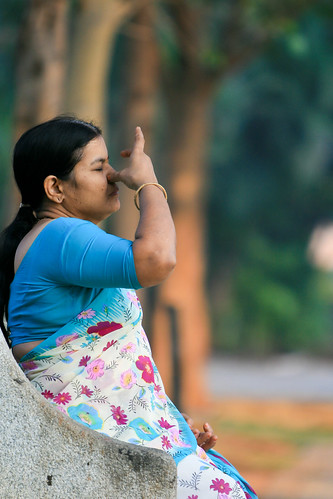
I tweaked my back two weekends in a row. I have some history of back pain, largely stemming from a jaunty twist in my spine (scoliosis). And, because I bend towards my knitting, bend towards my computer monitor, and otherwise stress out my upper back and neck, my upper back gets cranky now and then.
Once I’ve tweaked it, it is a long process of hot baths, ibuprophen, bodywork, arnica gel, and mostly just rest and time to undo whatever kink or constriction I’ve triggered.
Boring.
My interesting stories are the divergences from this pattern: I have had two experiences of spontaneous improvement in my neck/back pain: through pranayama breath, and at a music concert the other night.
Pranayama heals
The first spontaneous release I’ve experienced was in a yoga workshop taught in Ann Arbor by Navtej Johar at Sun-Moon Yoga. During the session, the pranayama breath work (shown in the photo above) released the kink that had stuck my neck for days. I have used pranayama breathing some since then, not enough considering its powerful effect that day….To encourage my practice, I recently picked up the Pranayama iPhone app by Saagara from itunes. I used it recently to relax during a bout of insomnia, and last night to further relax my back and neck. It helped!
Music heals

Sunday night was the only other time I’ve experienced seemingly “spontaneous” healing. I think I whacked out my upper back on Saturday by trying to move some largish rocks we have in our garden. I woke up Sunday morning kind of sprung behind my right shoulder blade. Later that day, I attended a concert at Rackham Auditorium. It was a reading by Alex Ross of his book The Rest Is Noise: Listening to the Twentieth Century, accompanied by Ethan Iverson on the piano. While I enjoyed the crisp and funny writing, I found the turbulent 20th Century history revealed in the lives and concerns of its composers daunting.
I was excited about the concert because I wanted to hear the music of the composers I’d read about. I also sometimes lose track of time, and so I was late for the performance and stressed out when I arrived. They wouldn’t seat us because the piece had started, so I waited, fretting, in the hall for the a slight break to be seated. Well, Rackham has very comfortable seats, and once I settled into our row, the soothing notes of the piano, even playing intellectual 12 tone music, which I’d expected to be annoying, had a physical effect on my body.
I don’t know what Ethan Iverson was playing in that particular moment, but in the middle of the performance that included Babbitt, Bartok, Gershwin, Ives, Ligeti, Jelly Roll Morton, Charlie Parker, Schoenberg, Shostakovich, Sibelius, Stravinsky, and Webern, I felt a muscle next to my shoulder blade go into a release that felt like an inverse spasm. It was a kind of drumming pattern of releases and then slight recontractions, but without pain. I don’t know what it was exactly – I’m going to guess, based on my experience with pranayama, that what might have helped was a relaxation in my own breathing in time to one of the pieces. Or, perhaps my absorption in the event let some other process take its course in my back. I doubt that new age spas around the world play a selection of 20th century classical music, but maybe they should. The concert had an unexpected and salutary effect on my body!



